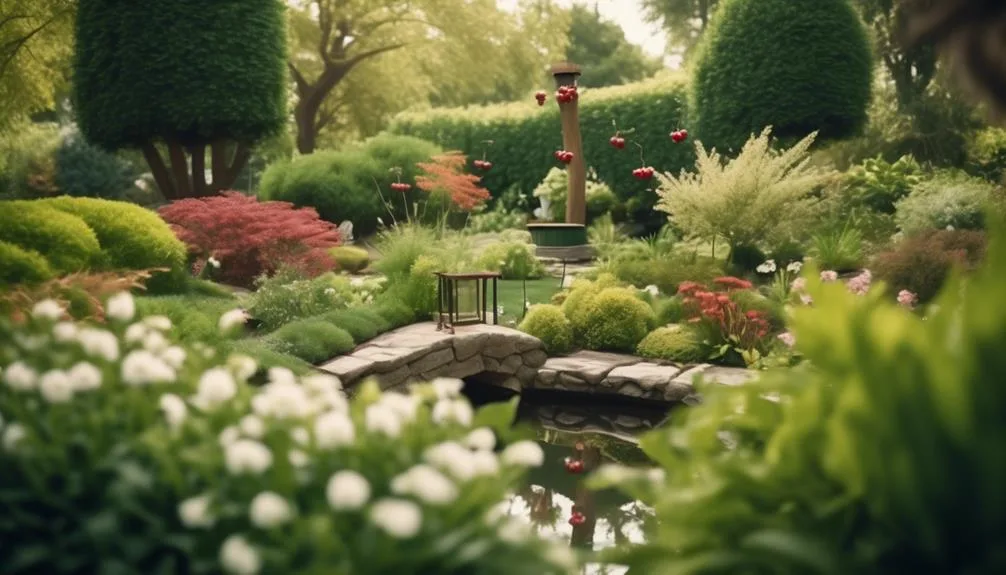Discover how cherry trees can create a thriving wildlife habitat in your backyard. They provide food, shelter, and attract birds and pollinators.
Learn how to turn your cherry tree grove into a haven for local wildlife with key steps and considerations.
Selecting the Right Cherry Tree Species
When choosing the right cherry tree species for your wildlife habitat, consider the specific needs of the local wildlife and the environmental conditions of your area. Cherry tree varieties like Yoshino, Kwanzan, and Okame are excellent choices for attracting and supporting wildlife.
Yoshino cherry trees, known for their delicate, pale pink blossoms, are particularly attractive to birds and pollinators. Kwanzan cherries, with their vibrant double-pink blooms, also provide a valuable food source for wildlife.
When selecting a cherry tree species, it's crucial to consider the soil requirements. Most cherry trees thrive in well-draining, slightly acidic soil. Ensure that the soil in your habitat area is suitable for the specific cherry tree species you choose.
Planting and Caring for Cherry Trees
To ensure the successful growth and health of your cherry trees, it's essential to plant them in a location that receives full sunlight and has well-draining soil. Here are some essential tips for planting and caring for your cherry trees:
- Soil Preparation: Before planting, ensure the soil is well-draining and rich in organic matter. Consider conducting a soil test to determine pH levels and nutrient deficiencies.
- Planting Depth: When planting your cherry trees, ensure that they're at the same depth as they were in the nursery, with the root flare just above the soil level.
- Pruning Techniques: Regularly prune your cherry trees to remove dead or diseased branches, maintain shape, and promote airflow and sunlight penetration within the canopy.
- Mulching: Apply a layer of mulch around the base of the tree to retain moisture, suppress weeds, and regulate soil temperature.
Following these guidelines will help your cherry trees flourish and thrive in your wildlife habitat.
Attracting Wildlife With Cherry Trees
Attract wildlife to your garden by strategically planting cherry trees to provide food, shelter, and nesting sites for a variety of bird and insect species.
Cherry trees produce an abundance of small fruits that are irresistible to birds, making them a perfect addition for bird feeding. Additionally, the cherry tree's blossoms attract pollinators such as bees and butterflies, contributing to the health and diversity of your garden ecosystem.
As the birds feast on the cherries, they also help to control insect populations, creating a natural balance within your garden.
The dense foliage and sturdy branches of cherry trees offer safe havens for birds to build their nests, providing essential shelter.
Creating Nesting and Roosting Sites
After attracting wildlife with cherry trees, the next step is to create nesting and roosting sites that provide essential shelter for birds and other wildlife in your garden. To do this, you can:
- Install bird houses and feeders to provide safe spaces for birds to build their nests and feed.
- Create brush piles, which offer cover and nesting spots for small mammals and birds.
- Place perches around your garden to give birds and other wildlife a place to rest and survey their surroundings.
- Provide sheltered areas such as dense shrubs or evergreen trees where wildlife can find protection from predators and harsh weather conditions.
Maintaining a Balanced Wildlife Habitat
Maintaining a balanced wildlife habitat requires thoughtful consideration of the ecosystem's interdependencies and the impact of human activity on the environment. Wildlife conservation is crucial for preserving the delicate balance of the ecosystem. By planting cherry trees, you contribute to creating a habitat that supports diverse wildlife. To maintain this balanced habitat, it's important to understand the interplay between different species and their environment. Ecosystem diversity is essential for the health and sustainability of the habitat. Here's a table to illustrate the key elements of maintaining a balanced wildlife habitat:
| Key Elements | Description |
|---|---|
| Wildlife Conservation | Protecting and preserving wildlife species and their habitats. |
| Ecosystem Diversity | Supporting a variety of plant and animal species to maintain a healthy and balanced ecosystem. |
Conclusion
Incorporating cherry trees into your garden creates a thriving wildlife habitat. By carefully selecting, planting, and maintaining these trees, you can attract a diverse range of birds and insects.
Embracing this natural environment not only enhances your surroundings but also fosters a sustainable ecosystem.
Are you ready to welcome the beauty of cherry trees and the life they bring?

My interest in trees started when I first saw the giant sequoias in Yosemite.
I was a teenager then, and I remember thinking, “I need to learn more about this.”
That moment stuck with me.
A few years later, I went on to study forestry at Michigan Tech.
Since graduating, I’ve worked in a mix of hands-on tree care and community education.
I’ve spent over ten years helping people understand how to plant, maintain, and protect the trees in their neighborhoods.
I don’t see trees as just part of the landscape.
They are living things that make a real difference in our daily lives.
